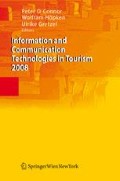Abstract
The study aims to examine if the Technology Acceptance Model (TAM) works for restaurant operations in using computing systems. In addition, we pursued other external variables, not included in the original TAM, to see how they affect perceived ease of use, perceived usefulness, and intention to use. These included user characteristics, system quality and organizational support. The survey collected data from restaurants in Kentucky, and the response rate was 25% based on the total contacts eligible. SPSS 15.0 and AMOS 7.0 were used for the data analysis. Structural Equation Modeling (SEM) was the primary analysis used to examine the proposed hypotheses developed in fulfilling the study objectives. The SEM statistics supported all the proposed hypotheses but one. The SEM results were interpreted relative to industry implications.
Preview
Unable to display preview. Download preview PDF.
References
Agarwal, R., & Karahanna, E. (2000). Time flies when you’re having fun: cognitive absorption and beliefs about information technology usage. MIS Quarterly, 24(4), 665–694.
Adams, D. A, Nelson, R. R., & Todd, P. A. (1992). Preceived usefulness, ease of use, and usage of information technology: a replication. MIS Quarterly, 16(2), 227–247.
Cheng, T.C.E., Lam, D.Y.C., & Yeung, A.C.L. (2006). Adoption of internet banking: An empirical study in Hong Kong. Decision Support Systems, 42(3), 1558–1572.
Davis, F. (1986). Technology Acceptance Model for Empirically Testing New End-User Information Systems: Theory and Results, unpublished doctoral dissertation, Massachusetts Institute of Technology.
Davis, F. (1989). Perceived Usefulness, Perceived Ease of Use and User Acceptance of Information Technology. MS Quarterly, 13(2), 319–340.
Davis, F.D., Bagozzi. R.P., & Warshaw, P.R. (1989). User acceptance of computer technology: a comparison of two theoretical models. Management Science, 35(8), 982–1003.
DeLone, W.H. (1988). Determinants of success for computer usage in small business. MIS Quarterly, 12(1), 51–61.
Ein-Dor, P., & Segev, E. (1978). Organizational context and the success of management information systems. Management Science, 24(10), 1067–1077.
Fishbein, M.. & Ajzen, I. (1975). Belief: Attitude, Intentions and Behavior: An Introduction to Theory and Research. Boston: Addison-Wesley.
Fuerst, W., & Cheney, P. Factors affecting the perceived utilization of computer-based decision support systems in the oil industry. Decision Sciences, 13(4), 554–569.
Gefen, D., & Straub, D. W. (1997). Gender differences in the perception and use of E-mail: An extension to the technology acceptance model. MIS Quarterly, 21(4), 389–400.
Gist, M.E. (1987). Self-efficacy: implications for organizational behavioral and human resource management. Academy of Management Review, 12,472–485.
Hair, J., Anderson, R., Tatham, R., & Black, W. (1992). Multivariate Data Analysis (2nd ed.). New York: Macmillan Publishing Company.
Hubona, G.S., & Cheney, P.H. (1994). System effectiveness of knowledge-based technology: the relationship of user performance and attitudinal measures. Proceedings of The Twenty-Seventh Annual Hawaii International Conference on System Sciences, 3, 532–541.
Igbaria, M. (1990). End-user computing effectiveness: a structural equation model. Omega, 18, 6.
Igbaria, M., Guimaraes, T., & Davis, G.B. (1995). Testing the determinants of microcomputer usage via a structural equation model. Journal of Management Information System, 11(4), 87–114.
Igbaria, M., & Chakrabati, A. (1990). Computer anxiety and attitudes towards microcomputer use. Behavior Information Technology, 9(3), 229–241
Igbaria, M., Parasuraman, S., & Pavri, F. (1990). A path analytic study of the determinants of microcomputer usage. Journal of Management Systems, 2(2), 1–14.
Igbaria, M., Pavri, F., & Huff, S. (1989). Microcomputer application: an empirical look at usage. Information Management, 16(4), 187–196.
Kim, T. G., Lee, J. H., & Law, R. (In Press). An empirical examination of the acceptance behaviour of hotel front office systems: An extended technology acceptance model. Tourism Management.
Kraemer, L., Danziger,.N., Dunkle, D.E., & King, J.L. (1993). The usefulness of computer-based information to public managers. MS Quarterly, 17(2), 129–148
Lam, T., Cho, V., & Qu, H. (2007). A study of hotel employee behavioral intentions towards adoption of information technology. International Journal of Hospitality Management, 26(1), 49–65.
Lee, H. Y., Kim, W. G., & Lee, Y. K. (2006). Testing the determinants of computerized reservation system users’ intention to use via a structural equation model. Journal of Hospitality & Tourism Research, 30(2), 246–266
Lee, D.S. (1986). Usage patterns and sources of assistance to personal computer users. MIS Quarterly, 10(4), 313–325.
Leitheiser, R.L., & Wetherbe, J.C. (1986). Service support levels: an organized approach to end-user computing. MIS Quarterly, 10(4), 337–349.
Lucss, H.C. (1978). Empirical evidence for a descriptive model of implementation. MIS Quarterly, 2(2), 271.
Lucas, H.C. (1975). Performance and the use of an information system. Management Science, 21(8), 908–919.
Moon, J.W., & Kim, Y.G. (2001). Extending the TAM for a world-wide-web context. Information and Management, 38(4), 217–230.
Nelson, R. R. (1990). Individual adjustment to information-driven technologies:a critical review, MIS Quarterly, 14(1), 87–98.
Pijpers, G. G. M., Bemelmans, T. M. A., Heemstra, F. J., & Montfort, K. A. G. M. (2001). Senior executives’ use of information technology. Information and Software Technology, 43(15), 959–971.
Robey, D., & Zeller, R.F. (1978). Factors affecting the success and failure of an information system for product quality. Interfaces, 8(2), 70–75.
Shneiderman, B. (1987). Designing the user interface: strategies for effective human-computer interaction. Reading, MA: Addison-Wesley.
Szajna, B. (1996). Empirical evaluation of the revised technology acceptance model. Management Science, 42(1), 85–92.
Wang, Y. S., Wang, Y. M., Lin, H. H., & Tang, T. I. (2003). Determinants of user acceptance of Internet banking: an empirical study. International Journal of Service Industry Management, 14(5), 501–519.
Zmud, R.W. (1979). Individual differences and MIS success: a review of the empirical literature. Management Sciences, 25(10), 966–979.
Author information
Authors and Affiliations
Editor information
Editors and Affiliations
Rights and permissions
Copyright information
© 2008 Springer-Verlag Wien
About this paper
Cite this paper
Ham, S., Kim, W.G., Forsythe, H.W. (2008). Determinants of Restaurant Employees’ Technology Use Intention: Validating Technology Acceptance Model with External Factors via Structural Equation Model. In: O’Connor, P., Höpken, W., Gretzel, U. (eds) Information and Communication Technologies in Tourism 2008. Springer, Vienna. https://doi.org/10.1007/978-3-211-77280-5_39
Download citation
DOI: https://doi.org/10.1007/978-3-211-77280-5_39
Publisher Name: Springer, Vienna
Print ISBN: 978-3-211-77279-9
Online ISBN: 978-3-211-77280-5

